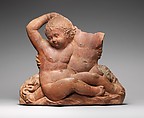Iphicles Saved from a Serpent by his Brother Hercules
Not on view
In myth, the Greek princess Alcmena gave birth simultaneously to sons by different fathers: Hercules, sired by Jupiter, and Iphicles, begotten of Amphitryon. Jupiter's vengeful wife Juno sent serpents to devour the boys in their cradle. Iphicles' cries of fright alerted Hercules, who grabbed the serpents and squeezed them to death. In this sizable fragment of a terracotta relief, Hercules, a hero even in babyhood, is distinguished by his larger torso and his foot grappling with a single snake at the bottom left. Hercules' head, an arm, and most of one leg are missing, but Iphicles is nearly complete.
The style of this piece, with rounded shapes arranged as planes in subtly graded low relief, owes much to the presence in Padua of the great Florentine sculptor Donatello in the 1450s. On the basis of its similarity to the bronze panels of angels in the church of Sant'Antonio in Padua, the work has been attributed to Antonio di Chelino, who was an assistant on Donatello's sculptures for the high altar of the church, known as the Santo. But with or without an attribution, this is a highly sympathetic and plenteously Donatelesque work whose rare secular subject no doubt appealed to Pauda's Humanist culture.
Due to rights restrictions, this image cannot be enlarged, viewed at full screen, or downloaded.

